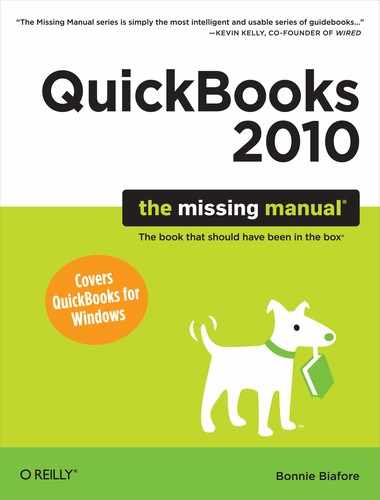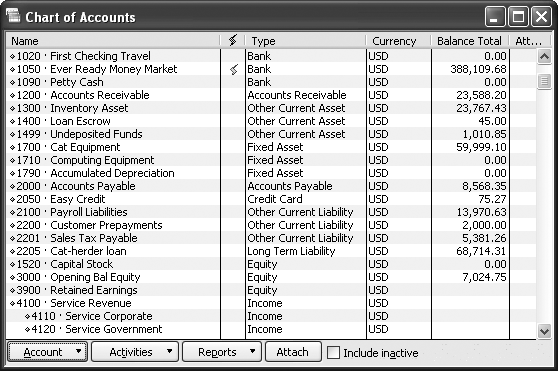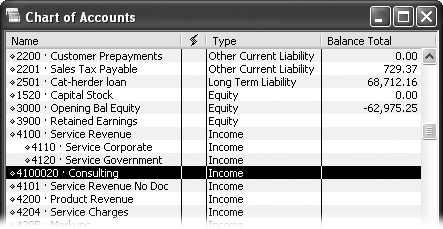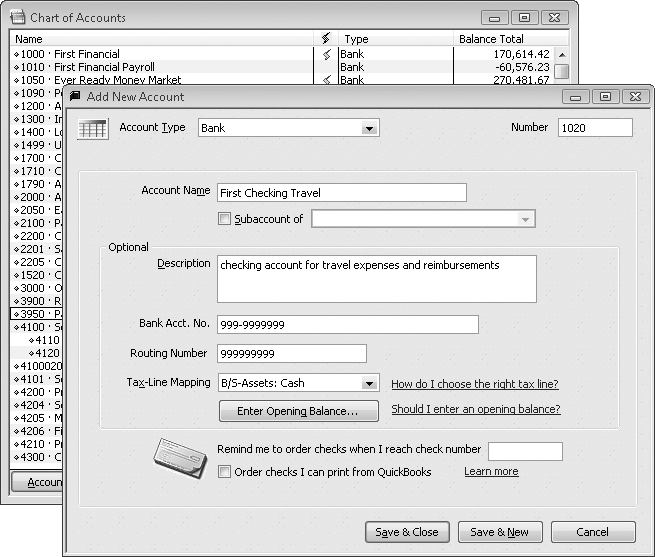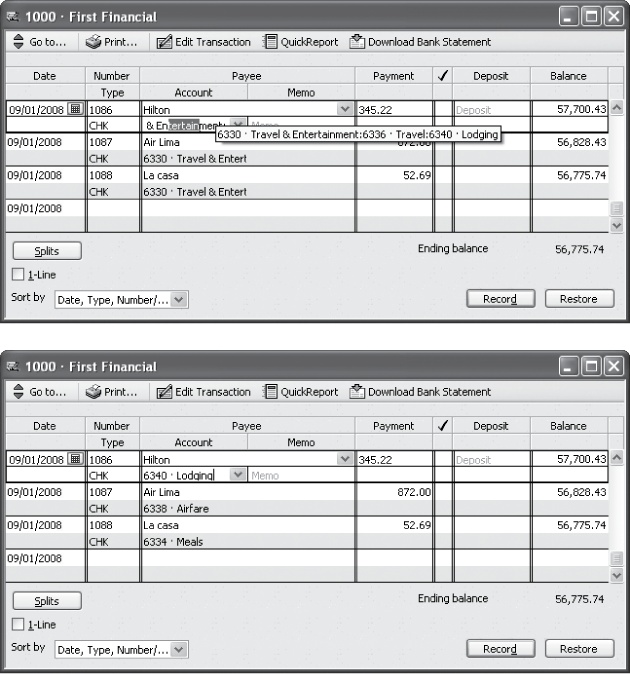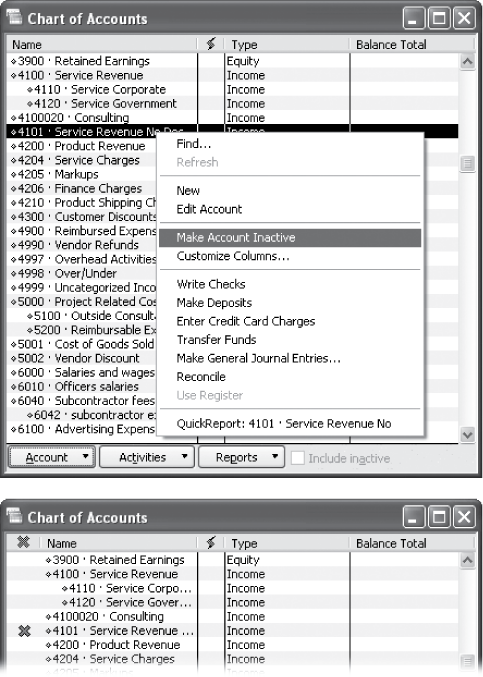Chapter 3. Setting Up a Chart of Accounts
If you’ve just started running a business and keeping books, all this talk of accounts, credits, and debits might have you flummoxed. Accounting is a cross between mathematics and the mystical arts that records and reports the financial performance of an organization. The end result of bookkeeping and accounting is a set of financial statements (The Profit & Loss Report), but the starting point is the chart of accounts.
In accounting, an account is more than an account you have at a financial institution; it’s like a bucket for holding money. When you earn money, you document those earnings in an income account, just as you might toss the day’s take at the lemonade stand into the jar on your desk. When you buy supplies for your business, that expense shows up in an expense account like the pocket of receipts you carry around. If you buy a building, its value ends up in an asset account. And if you borrow money to buy that building, the mortgage owed shows up in a liability account.
Accounts come in a variety of types to reflect whether you’ve earned or spent money, whether you own something or owe money to someone else, as well as a few other financial situations. The chart of accounts is a list of all the accounts you use to track money in your business and what type each one is.
Neophytes and experienced business folks alike will be relieved to know that no one has to build a chart of accounts from scratch in QuickBooks. This chapter explains how to get a ready-made chart of accounts for your business and what to do with it once you’ve got it. If you want to add or modify accounts in your chart of accounts, you’ll learn about that, too.
Acquiring a Chart of Accounts
The easiest—though probably not the cheapest—way to get a chart of accounts is from your accountant. Accountants understand the accounting guidelines set by the Financial Accounting Standards Board (FASB—pronounced “faz bee”—a private-sector organization that sets standards with the SEC’s blessing). When your accountant builds a QuickBooks chart of accounts for you, you can be reasonably sure that you have the accounts you need to track your business and that those accounts conform to accounting standards.
Note
Don’t worry—getting an accountant to build a chart of accounts for you probably won’t bust your budget, since your accountant won’t start from scratch either. Many financial professionals maintain spreadsheets of accounts and build a chart of accounts by importing a customized account list into QuickBooks. Or, they may keep QuickBooks company files around to use as templates for new files.
Using a QuickBooks Chart of Accounts
If you’ve opted to work without an accountant, QuickBooks tries to help you do the right thing accounting-wise. If you use QuickBooks’ EasyStep Interview (Company Information) to create your QuickBooks file, you can tell the program to create income, expense, and bank accounts for you. When you choose an industry during the Interview, QuickBooks selects accounts typical for that industry, which you can use as a starting point for your chart of accounts.
If the Chart of Accounts window is devoid of accounts after you’ve completed the EasyStep Interview, there’s no need for concern. At the bottom of the Chart of Accounts window (press Ctrl+A to open it), turn on the “Include inactive” checkbox. If an X appears to the left of an account that you want to use, click the X to reactivate the account (see Hiding and Deleting Accounts for more about hiding and reactivating accounts).
With your QuickBooks chart of accounts in place, you can add more accounts, hide accounts you don’t need, merge accounts, or edit the accounts on the list—all of which are described in the rest of this chapter.
Note
Intuit offers QuickBooks Premier editions for several different business types: accounting, construction, manufacturing, nonprofit, professional services, retail, and wholesale. With an industry-specific Premier edition, QuickBooks provides a chart of accounts, an item list, payroll items, and preferences already tuned to your industry. The industry-specific editions also have features unique to each industry, like enhanced job costing in the Contractor Edition. You have to decide whether these features are worth a few hundred dollars more than the QuickBooks Pro price tag.
Importing a Chart of Accounts
If you don’t like the chart of accounts that QuickBooks delivers, how about one built by experts and available at no charge? A quick search on the Web for “QuickBooks chart of accounts” returns links to sites with predefined charts of accounts.
For example, a chart of accounts (and item list, other lists, customized forms and reports) for the construction industry is available at no charge from www.powertoolssoftware.com. At www.rrgconsulting.com/restaurant_coa.htm, you can download a free .iif file with a restaurant-oriented chart of accounts that you can import into QuickBooks.
In the not-for-profit world, the National Center for Charitable Statistics website (http://nccs.urban.org/projects/ucoa.cfm) includes downloadable QuickBooks files that contain the Unified Chart of Accounts for nonprofits (known as the UCOA). You can download a QuickBooks backup file of a nonprofit company file complete with chart of accounts, an .iif file that you can import (see the next section) into QuickBooks, or a backup file for the Mac version of QuickBooks.
Importing a Downloaded Chart of Accounts
Once you download an .iif file with a chart of accounts, you can import that file into a QuickBooks company file. Because you’re importing a chart of accounts, you want to create your company file with basic info about your company and as few accounts as possible in the Chart of Accounts list. Here’s how you set up a QuickBooks company file to import a chart of accounts from an .iif file:
Choose File → New Company. In the EasyStep Interview window, click Skip Interview.
The “Enter your company information” window appears. As described on Company Information, enter the company name, legal name, tax ID, and other 411 about your company.
Click Next.
QuickBooks takes you through data entry screens where you select the type of business entity (LLC, corporation, and so on), and the start of your fiscal year.
When the “Select your industry” screen appears, scroll to the bottom of the list, and then choose Other/None. Click Next.
Choosing Other/None tells QuickBooks to create a company file with only a handful of accounts. The .iif file you import (step 6) creates the rest of your accounts.
In the “Create your company file” screen that appears, click Finish to create your company file.
The “Filename for New Company” dialog box appears.
Choose the folder and filename for the company file as described on Creating Your Company File, and then click Save.
QuickBooks creates the company file and opens it. Now you’re ready to import your chart of accounts.
Choose File → Utilities → Import → IIF Files.
QuickBooks opens the Import dialog box to the folder where you stored your company file. It also sets the “Files of type” box to IIF Files (*.IIF).
Navigate to the folder that contains the .iif file and double-click the filename.
A message box appears that displays progress for the import. If all goes well, QuickBooks then displays a message box that tells you that it imported the data successfully. Click OK. If the Chart of Accounts window is open (Ctrl+A), you’ll see it blossom with imported accounts. If QuickBooks ran into other problems with the data in your .iif file, it tells you that it didn’t import the data successfully.
Account Naming and Numbering
Accountants and bookkeepers tend to refer to accounts by both numbers and names. This section explains why you should set up naming and numbering conventions—and suggests some rules you can follow—but it won’t explain the meaning of all the different names you’ll find in your chart of accounts. If you accept the accounts that QuickBooks recommends in the EasyStep Interview, your accounts already have assigned account numbers, as shown in Figure 3-1. You might think that lets you off the hook. But by taking the time to learn standard account numbers and names, you’ll find working with accounts more logical, and you’ll understand more of what your accountant and bookkeeper say.
Setting Up Account Numbers
Companies reserve ranges of numbers for different types of accounts, so you can identify the type of account by its account number alone. Business models vary, so you’ll find account numbers carved up in different ways depending on the business. Think about your personal finances: You spend money on lots of different things, but your income derives from a precious few sources. Businesses and nonprofits are no different. You might find income accounts from 4000 to 4999 and expense accounts using numbers anywhere from 5000 through 9999 (see Table 3-1).
Number Range | Account Type |
1000–1999 | Assets |
2000–2999 | Liabilities |
3000–3999 | Equity |
4000–4999 | Income |
5000–5999 | Sales, cost of goods sold, or expenses |
6000–6999 | Expenses or other income |
7000–7999 | Expenses or other income |
8000–8999 | Expenses or other expenses |
9000–9999 | Other expenses |
Note
The account-numbering scheme is consistent for most types of businesses until you reach the number 4999. Some companies require more income accounts, but in most businesses, expense accounts are the most plentiful.
Account numbering conventions don’t end with number ranges for account types. If you read annual reports as a hobby, you know that companies further compartmentalize their finances. For example, assets and liabilities get split into current and long-term categories. Current means something happens in the next 12 months, such as a loan that’s due in 3 months. Long-term is anything beyond 12 months. Typically, companies show assets and liabilities progressing from the shortest to the longest term, and the asset and liability account numbers follow suit. Here’s one way to allocate the asset account numbers for current and progressively longer-term assets:
1000–1099. Immediately available cash, such as a checking account, savings account, or petty cash.
1100–1499. Assets you can convert into cash within a few months to a year, including accounts receivable, inventory assets, and other current assets.
1500–1799. Long-term assets, such as land, buildings, furniture, and other fixed assets.
1800–1999. Other assets.
Companies also break down expenses into smaller categories. Many companies keep an eye on whether the sales team is doing its job by tracking sales expenses separately and monitoring the ratio of sales to sales expenses. Sales expenses often appear in the number range from 5000 through 5999. QuickBooks reinforces this standard by automatically creating a “Cost of Goods Sold” account with the account number 5001. Other companies assign overhead expenses to accounts in the 7000 to 7999 range, so they can assign a portion of those expenses to each job performed.
Tip
When you add new accounts to your chart of accounts, increment the account number by 5 or 10 to leave room in the numbering scheme for similar accounts that you might need in the future. For example, if your checking account number is 1000, assign 1005 or 1010, not 1001, to your new savings account.
In QuickBooks, an account number can be up to seven digits long, but QuickBooks sorts numbers beginning with the leftmost digit, as shown in Figure 3-2. If you want to categorize in excruciating detail, slice your number ranges into sets of 10,000. For example, assets range from 10000 to 19999; income accounts span 40000 to 49999, and so on.
Standardizing Account Names
Accounts should be unique in name and function because you don’t need two accounts for the same type of income, expense, or financial bucket. For example, if you consider advertising and marketing as two distinctly different activities, create an account for each. But if advertising and marketing blur in your eyes, create one account with a name like Marketing & Advertising.
QuickBooks does its part to enforce unique account names. Suppose you try to create a new expense account with the name Samovar Rental, but an account by that name already exists. QuickBooks displays the message “This name is already in use. Please use another name.” What QuickBooks can’t do is ensure that each account represents a unique category of money. Without a naming standard, you could end up with multiple accounts with unique names, each representing the same category, as shown by the following names for an account used to track postage:
| Expense-postage |
| Postage |
| Postage and delivery |
| Shipping |
Warning
QuickBooks won’t enforce your naming standards. After you set the rules for account names, write them down so that you don’t forget what they are. A consistent written standard encourages everyone (yourself included) to trust and follow the naming rules. Also, urge everyone to display inactive accounts (Deleting Accounts) and then scan the chart of accounts, using synonyms to see if such an account already exists, before creating a new one. These rules are easier to enforce if you limit the number of people who can create and edit accounts (Restricting Access to Features and Data).
Creating Accounts and Subaccounts
Different types of accounts represent dramatically different financial animals, as described in the box on Creating an Account. The good news is that accounts of every type share most of the same fields, so you have to remember only one procedure for creating accounts.
If you look closely at the chart of accounts list in Figure 3-2, you’ll notice that accounts fall into two main categories: those with balances and those without. If you’re really on your toes, you might also notice that accounts with balances are the ones that appear on the Balance Sheet report. Accounts without balances appear on the Profit & Loss report. To learn more about financial statements and the accounts they reference, see Chapter 17.
Creating an Account
After you’ve had your business for a while, you won’t add new accounts very often. However, you might need a new account if you start up a new line of income, take on a mortgage for your new office building, or want a new expense account for the emu infertility insurance you took out for your bird farm. The procedure for creating accounts is simple, which is a refreshing change from many accounting tasks.
Before you can create an account, you have to open the Chart of Accounts window. Because the chart of accounts is central to accounting, QuickBooks gives you several ways to open this window:
The easiest way is by pressing Ctrl+A (which you can do from anywhere in the program).
At the top right of the Home page, in the Company section, click Chart of Accounts.
In the menu bar, choose Lists → Chart of Accounts.
On the icon bar, click Acct. (If you don’t see the Acct icon, you may need to add the icon to the icon bar or reorder the icons so the Acct icon is visible.) See Building Your Favorites Menu to learn how to customize the icon bar.
Tip
You can create accounts on the fly by clicking <Add New> in any account drop-down list. Suppose you create a new service item (in the Item List window, press Ctrl+N) and want a new income account for what you earn with the service. In the New Item dialog box, scroll to the top of the Account drop-down list and choose <Add New>. Fill in the info and then click Save & Close. QuickBooks fills in the Account box with the new account, and you can finish creating your item.
Once you’ve opened the Chart of Accounts window, here’s how to create an account:
To open the Add New Account dialog box, press Ctrl+N.
Alternatively, on the menu bar at the bottom of the Chart of Accounts window, click Account, and then choose New. Or, right-click anywhere in the Chart of Accounts window, and then choose New from the shortcut menu.
QuickBooks opens the Add New Account dialog box, shown in Figure 3-3.
Select the option for the type of account you want to create, and then click Continue.
The Add New Account window lists the most common types of accounts. If the type you want isn’t listed—Other Current Liability, for example—select the Other Account Types option, and then choose the type from the drop-down menu (Figure 3-3).
Figure 3-3. If you aren’t sure which type you should choose, first read the box on Creating an Account. In the Add New Account window, select one of the options. A description with examples of that type of account appears on the right side of the window. If this description doesn’t help, click More to read a Help topic that explains when to use this type of account. The “Help me choose the right account type” link at the bottom of the window isn’t so helpful. It tells you to click More to read the account type Help topics.In the Number box, type the chart of accounts account number you want to use.
If you keep the chart of accounts in view while you create new accounts, as in Figure 3-4 review the account numbers for similar types of accounts. Then, when you generate your new account number by incrementing an existing account number by 5 or 10, the new account snuggles in nicely with its compatriots in the chart of accounts.
Note
If the Number box doesn’t appear, you haven’t turned on account numbers in QuickBooks preferences. To turn on account numbers, choose Edit → Preferences. In the Edit Preferences dialog box, click the Accounting icon, and then click the Company Preferences tab. Turn on the “Use account numbers” checkbox.
In the Account Name box, type the name for the account.
See the box on Creating Accounts and Subaccounts for tips on effective account names. If you create an account and don’t see one of the fields mentioned here, it simply doesn’t apply to that account type.
If you want to turn an account into a subaccount (see the box on Creating an Account), turn on the “Subaccount of” checkbox. Then, in the drop-down list, choose the account that you want to act as the parent.
In the chart of accounts, subaccounts are indented to differentiate them from parent accounts.
Figure 3-4. The Bank account type includes every account field except for the Note field. It also includes one field that you won’t find on any other account type: If you want QuickBooks to remind you to order checks, in the “Remind me to order checks when I reach check number” box, type the check number you want to use as a trigger. If you want the program to open the browser to the Order Supplies web page, turn on the “Order checks I can print from QuickBooks” checkbox and save the account. If you get checks from somewhere else, just reorder checks the way you normally do.If you’ve turned on QuickBooks’ multiple currency preference, the Currency box appears below the “Subaccount of” checkbox. If the currency for the account is different from the one that QuickBooks fills in, choose the currency in the drop-down list.
If you do business in more than one currency, you can turn on multiple currencies in QuickBooks, as described on Multiple Currencies.
To add a more meaningful description of the account, fill in the Description box.
For example, you can define whether a bank account is linked to another account or give examples of the types of expenses that apply to a particular expense account. The account Description field can hold up to 100 characters.
For several types of accounts, you’ll see a field for an account number (one that corresponds to the account number assigned by a financial institution). You’ll fill that in next.
In the Bank Acct. No. box, type the account number for your real-world account at your financial institution, like a checking account, money market account, or mortgage.
This field appears for Bank, Other Current Asset, Other Asset, Credit Card, Other Current Liability, and Long-term Liability account types, but the field’s label changes depending on the account type. For example, the label for a credit card account is Credit Card Acct. No, while the label for an Other Current Liability account is simply Account No.
When an account type doesn’t include a field for an account number, you’ll see the Note field instead. You can use this field to store any additional information you want to document about the account.
In the Routing Number box, type the routing number for your bank.
The routing number is a nine-digit number in funny-looking digits at the bottom of your checks.
To associate the account with a tax form and a specific line on that tax form, in the Tax-Line Mapping drop-down menu, choose the entry for the appropriate tax form and tax line.
The Tax-Line Mapping field is unassigned if you haven’t specified the tax form that your company files with the IRS. To see QuickBooks tax line assignments, start by choosing Company → Company Information. In the Company Information dialog box, in the Income Tax Form Used field, choose the appropriate tax form for your business, such as Form 1120S (S Corporation).
If QuickBooks hasn’t assigned a tax line for you, you can scan the entries in the drop-down list for a likely match. If you don’t find an entry that seems right, or if QuickBooks tells you the one you chose isn’t compatible with the account type, your best bet is to call your accountant or the IRS. You can also get a hint for an appropriate tax line for the account you’re creating by examining one of QuickBooks’ sample files (Before You Create Your Company File).
To remove a tax line from an account, in the drop-down list, choose <Unassigned>.
Note
For a brand-new account, the value for the Opening Balance field is easy—it’s zero. But if you’re setting up QuickBooks with accounts that existed prior to your QuickBooks start date, those accounts do have opening balances. Even so, you should leave the Opening Balance field blank. Check out the box below to learn how to specify opening balances for all your accounts in just a few steps.
Click Save & New to save the current account and begin the next one.
If you want to save the account you just created and close the Add New Account dialog box, click Save & Close; or click Cancel to discard the account in progress and close the Add New Account dialog box.
If the Set Up Online Services dialog box appears, click Yes if you want to set up a bank account for online services.
If you want to set up the account for online banking later—or never—click No. If you click Yes, QuickBooks’ windows close while you go through the setup. (See Chapter 22 to learn about online services and QuickBooks.)
Viewing Account Names and Numbers
Perhaps it’s the nature of accounting, but financial professionals put great store in account numbers. You can earn the eternal gratitude of your bookkeeper or accountant by assigning and displaying account numbers in QuickBooks.
Turning on the “Use account numbers” preference (Accounting) displays account numbers in the Chart of Accounts window, account drop-down lists, and account fields. With the “Use account numbers” checkbox turned on, the Add New Account and Edit Account dialog boxes display the Number box, so you can add or modify an account’s number.
Note
Turning off the “Use account numbers” checkbox doesn’t remove account numbers you’ve already added. You can see them again by simply turning the checkbox back on. However, you can’t add account numbers to any accounts that you create while the checkbox is turned off. If you create an account anyway, you can edit it (Modifying Accounts) to add the account number.
When you use subaccounts, QuickBooks displays both the parent account name and the subaccount name in account fields, which often makes it impossible to tell which account a transaction uses, as Figure 3-5 shows. If you use account numbers and want to see only the lowest-level subaccount in Account fields, turn on the “Show lowest subaccount only” checkbox (Preferences for Saving the Desktop).
Modifying Accounts
If you stick to your account numbering and naming conventions, you’ll have few reasons to edit accounts. In the Edit Account dialog box, you can tweak an account name or description, adjust an account number to make room for new accounts, or change an account’s level in the chart of accounts hierarchy.
You’re not likely to change the Type field unless you chose the wrong type when you created the account. If you do want to change the account type, back up your QuickBooks file first (see Backing Up Files), in case the change has effects that you didn’t anticipate. QuickBooks has several restrictions on changing account types. You can’t change account types under the following conditions:
An account has subaccounts.
You try to change an Accounts Receivable or Accounts Payable account to another account type, or vice versa.
QuickBooks automatically created the account, like Undeposited Funds.
To modify an account, in the Chart of Accounts window, select the account you want to edit and press Ctrl+E. In the Edit Account dialog box, make the changes you want, and then click OK when you’re done. You can also open the Edit Account dialog box by clicking Account at the bottom of the Chart of Accounts window and then choosing Edit Account from the drop-down menu.
Tip
The Chart of Accounts window works much like other list windows. For example, you can sort the account list by different columns or drag accounts in the list to a different location. See Sorting Lists to learn how to sort and rearrange lists.
Hiding and Deleting Accounts
If you create an account by mistake, you can delete it. However, because QuickBooks drops your financial transactions into account buckets and you don’t want to throw away historical information, you’ll usually want to hide accounts that you don’t use anymore instead of deleting them. For example, you wouldn’t delete your Nutrition Service income account just because you’ve discontinued your nutrition consulting service to focus on selling your new book, The See Food Diet. The income you earned from that service in the past needs to stay in your records.
Hiding Accounts
The records of past transactions are important, whether you want to review the amount of business you’ve received from a customer or the IRS is asking unsettling questions. Hiding accounts doesn’t mean you withhold key financial information from prying eyes. When you hide an account, the account continues to hold your historical transactions, but it doesn’t appear in QuickBooks’ account lists, so you can’t choose it by mistake with a misplaced mouse click.
Hiding and reactivating accounts (Figure 3-6) also comes in handy when you use QuickBooks’ predefined charts of accounts, explained on Using a QuickBooks Chart of Accounts. If QuickBooks overwhelms you with accounts you don’t think you need, hide the accounts for the time being. When you find yourself saying, “Gosh, I wish I had an account for the accumulated depreciation of vehicles,” the solution might be as simple as reactivating a hidden account.
Deleting Accounts
You can delete an account only if nothing in QuickBooks references it in any way. An account with references within QuickBooks is a red flag that deleting it might not be the right choice. If that red flag isn’t enough to deter you, the sheer tedium of removing references to an account should nudge you toward hiding the account instead. If you insist on deleting an account, here are the conditions that prevent you from doing so and what you have to do to remove the constraints:
An item uses the account. If you create any items that use the account as an income account, an expense account, cost of goods sold account, or inventory asset account, you can’t delete the account. Edit the items to use other accounts, as described on Modifying Items.
The account has subaccounts. You have to delete all subaccounts before you can delete the parent account.
Payroll uses the account. You can’t delete an account if your payroll setup uses it. See Chapter 14 to learn how to modify your payroll and payroll liabilities accounts.
At least one transaction references the account. If you create a transaction that uses the account, either edit the transaction to use a different account or consider hiding the account if you want to keep the transaction the way it is.
The account has a balance. An account balance comes from either an opening balance transaction or other transactions that reference the account. You remove an account balance by deleting all the transactions in the account (or reassigning them to another account).
To delete transactions, in the Chart of Accounts window, double-click the account name. For bank accounts and other accounts with balances, QuickBooks opens a register window, where you can select a transaction and then press Ctrl+D to delete that transaction.
For accounts without balances, QuickBooks opens an Account QuickReport window. To delete a transaction that appears in the report, double-click the transaction. QuickBooks opens a dialog box (for instance, the Write Checks dialog box appears if the transaction is a check). Choose Edit → Delete Check or the corresponding delete command for the type of transaction you chose.
After you’ve deleted all references to the account, in the Chart of Accounts window, select the account you want to delete, and then press Ctrl+D or, on the QuickBooks menu bar, choose Edit → Delete Account. If references to the account are indeed gone, QuickBooks asks you to confirm that you want to delete the account; click Yes.
Merging Accounts
Suppose you find multiple accounts for the same purpose—Postage and Mail Expense, say—lurking in your chart of accounts. Rather than punishing your QuickBooks experts, it’s more productive to merge the accounts into one and then remind everyone who creates accounts in QuickBooks about your account naming conventions. (You haven’t gotten around to setting up account naming conventions? See Creating Accounts and Subaccounts for some guidelines.)
Tip
Before you merge accounts, see what your accountant thinks. There’s no going back once you’ve merged two accounts—they’re merged for good. And the QuickBooks audit trail (Setting Access Rights) doesn’t keep track of this kind of change.
When you merge accounts, QuickBooks sweeps all the transactions from both accounts into the account that you keep. Each type of account has a distinct purpose, so you can merge accounts only if they’re the same type. As an experienced manager, you can imagine the havoc that merging income and expense accounts would cause in your financial statements.
Note
If you find two accounts with similar names but different types, those accounts might not represent the same thing. For instance, a Telephone Ex. expense account probably represents what you pay for your monthly telephone service, while the Telephone Eq. asset account might represent the big telephone switch that your mega-corporation owns. In this situation, the accounts should be separate, although more meaningful names and descriptions would help differentiate them.
Here’s how to eliminate an extraneous account:
Switch to single-user mode, as described on Switching Between Multi-User and Single-User Mode.
You have to be in single-user mode to merge accounts. Be nice to your fellow QuickBooks workers by making these changes outside of working hours. If you have to merge accounts during the workday, remember to tell your coworkers they can log into the program after you’ve switched the company file back to multi-user mode.
To open the Chart of Accounts window, press Ctrl+A. Then, in the chart of accounts list, select the name of the account that you want to eliminate and press Ctrl+E.
The Edit Account dialog box opens.
In the Edit Account dialog box, change the account number and name to match the values for the account you want to keep.
As long as you get the letters and numbers right, QuickBooks takes care of matching uppercase and lowercase for you.
If you don’t remember the number and name of the account you’re keeping, drag the Chart of Accounts window and the Edit Account dialog box so you can see both at the same time. If QuickBooks won’t let you do that, you might have the One Window preference set. See Choosing the Online Banking Mode to learn how to change your window display to show multiple windows.
Click OK.
QuickBooks displays a message informing you that the name is in use and asks if you want to merge the accounts.
Click Yes to merge the accounts.
In the chart of accounts list, the account you renamed disappears and any transactions for that account now belong to the account you kept.
